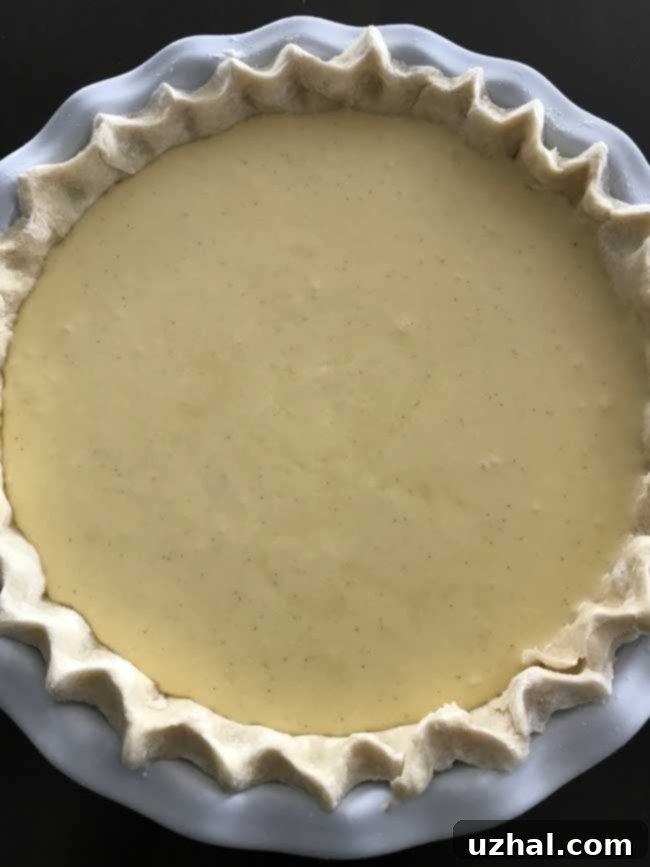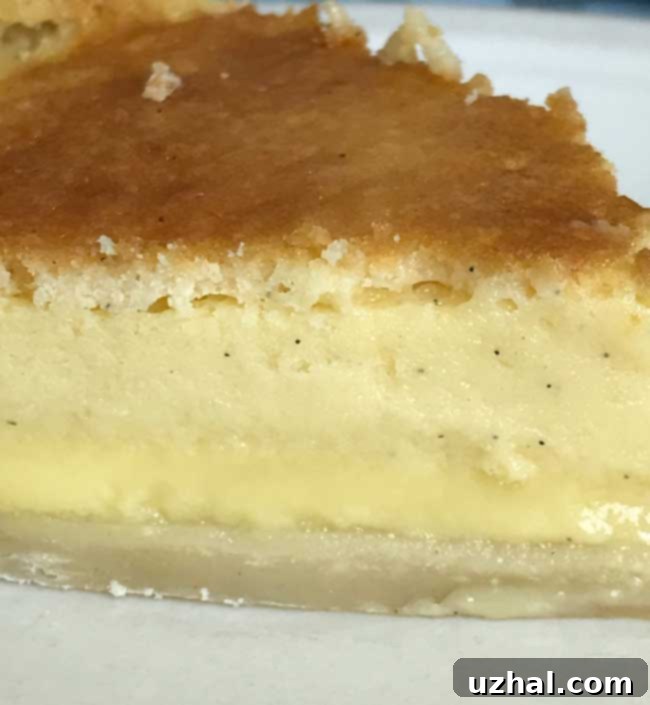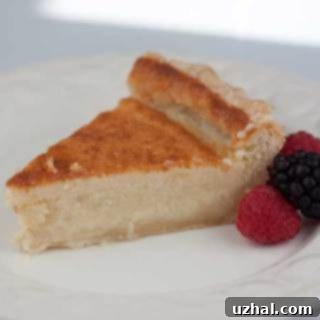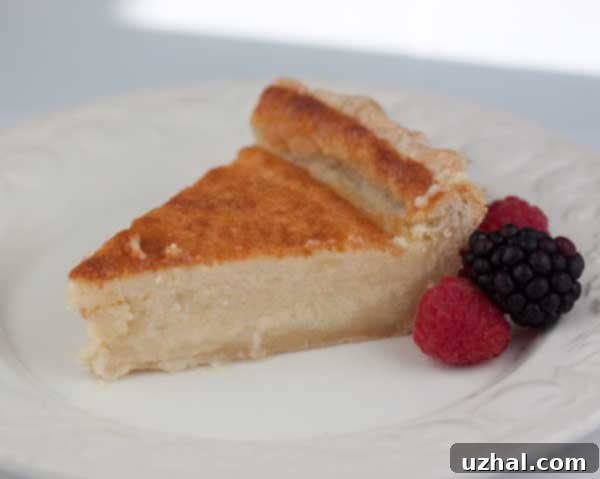Classic Southern Buttermilk Pie: Your Ultimate Guide to a Beloved Dessert
There are some desserts that just quietly steal your heart, and for me, Buttermilk Pie is one of them. For years, it wasn’t even on my radar. My perception, like many others, was that it might be too simple, perhaps even a bit bland compared to its more flamboyant counterparts. That all changed one memorable Thanksgiving. My sister-in-law arrived with a pie that wasn’t homemade by her, but acquired from a local legend in Llano, a town renowned for its culinary delights, especially this particular pie. The moment that first slice hit our plates, a hush fell over the room, quickly followed by a chorus of appreciation. Each bite was a revelation – a delicate balance of creamy texture, subtle sweetness, and that unmistakable tangy note that defines a perfect buttermilk pie. From that day forward, I was on a mission: to uncover the secret to creating a truly exceptional buttermilk pie in my own kitchen.
This quest led me down a delightful path of experimentation, countless taste tests, and a deep dive into the rich history of Southern baking. What I discovered was a treasure trove of tips, tricks, and, most importantly, a recipe that consistently delivers that irresistible charm. This article isn’t just about making a pie; it’s about embracing a tradition, understanding the nuances of simple ingredients, and ultimately, crafting a dessert that will undoubtedly become a new favorite for you and your loved ones, just as it did for me.
Jump to Recipe
The Quest for the Perfect Buttermilk Pie Recipe
My journey to replicate that unforgettable Thanksgiving pie wasn’t short, but it was incredibly rewarding. In fact, it led me to not just one, but two fantastic buttermilk pie recipes. One of these, sometimes referred to as Magnolia Pie, utilizes buttermilk powder, offering a convenient alternative for those who don’t always have fresh buttermilk on hand. However, the star of today’s show is the second recipe, the one I’m sharing with you below. Initially, I perfected this recipe using regular low-fat buttermilk, which yielded consistently delicious results. But a recent discovery elevated it to an entirely new level: using whole milk buttermilk, like Kemps Cultured Buttermilk Blend with Whole Milk, transforms the pie into something truly extraordinary. The richness of whole milk buttermilk provides a depth of flavor and a silky texture that truly shines. Before it enters the oven, the pie filling has a thick, custardy consistency, promising the delightful transformation to come.

What truly sets a great buttermilk pie apart is its remarkable texture. It begins as a somewhat thick, almost custardy batter, but through the magic of baking, it transforms into a smooth, creamy, and wonderfully tart pie. While it typically bakes into a single, cohesive layer, an interesting phenomenon occurred when I tested it with the full-fat buttermilk: it separated into two distinct layers, each delightful in its own right, adding an unexpected visual appeal to the already delicious treat. This slight separation doesn’t detract from the flavor; rather, it often indicates a richer, more decadent pie, making it a truly unique Southern dessert.

To achieve the pinnacle of flavor, don’t skimp on the quality of your ingredients. Pure vanilla extract is good, but for an unparalleled aromatic depth, I highly recommend using Nielsen Massey Vanilla Paste. Its concentrated flavor and tiny specks of vanilla bean will elevate your pie from great to extraordinary. Equally important is the foundation: a truly exceptional butter pie crust. While you’ll need an unbaked crust for this recipe, the quality of your butter and your technique in preparing the crust will make a significant difference in the final taste and texture of your homemade buttermilk pie. A flaky, buttery crust provides the perfect counterpoint to the silky, tangy filling, creating a harmonious culinary experience.
The Enduring Charm of Southern Buttermilk Pie
Buttermilk pie holds a special place in the hearts of many, particularly throughout the American South. Often called a “pantry pie,” it earned this moniker because its ingredients were almost always readily available in a well-stocked Southern kitchen: buttermilk, eggs, sugar, butter, and flour. There was no need for fresh fruit or exotic spices, making it a reliable and comforting dessert to whip up at a moment’s notice. Its humble origins contribute to its timeless appeal, embodying the spirit of resourceful and delicious home cooking that is characteristic of classic Southern cuisine.
Unlike rich, dense chocolate pies or vibrant fruit tarts, buttermilk pie offers a unique profile. It’s a custard pie, but with a distinct tang from the buttermilk that cuts through the sweetness, preventing it from being overly cloying. The texture is key: a smooth, almost silken custard that melts in your mouth, encased in a crisp, buttery crust. It’s a taste of nostalgia, a bite of history, and a testament to how simple ingredients, combined with care, can create something truly extraordinary. Whether served warm or chilled, with a dollop of whipped cream or a sprinkle of fresh berries, it’s a dessert that speaks of comfort and tradition, making it an essential part of any Southern gathering.
Unlocking Flavor: The Power of Quality Ingredients for Your Buttermilk Pie
While the ingredients for a classic buttermilk pie are simple, their quality significantly impacts the final product. Let’s delve a little deeper into each component, focusing on why certain choices will lead to the best possible buttermilk pie:
- Buttermilk: As highlighted, the type of buttermilk you use truly matters. Full-fat, cultured buttermilk will give you the richest, creamiest texture and the most pronounced tangy flavor. This full-bodied buttermilk creates a more luxurious custard. If you only have low-fat buttermilk, your pie will still be delicious, but for that truly indulgent experience, seek out the full-fat version. It’s crucial not to substitute with regular milk and lemon juice; while it may mimic the acidity, it won’t replicate the complex flavor or the thick, creamy texture that genuine buttermilk provides.
- Butter: Opt for high-quality unsalted butter. European-style butters with a higher fat content can significantly contribute to a richer flavor and a smoother mouthfeel in your pie filling. Melting it to a “goopy” state, rather than fully liquid, is a critical step for achieving the right texture in the filling. This ensures the butter emulsifies properly with the sugar and eggs, leading to a velvety, less grainy custard that perfectly complements the tang of the buttermilk.
- Vanilla: In a pie with such simple flavors, vanilla is not just a supporting actor; it’s a co-star. Using a premium pure vanilla extract or, even better, a vanilla bean paste, will infuse your pie with a warm, complex aroma and flavor that cheaper imitations simply cannot achieve. The tiny specks of vanilla bean from the paste also add an elegant visual touch. The subtle, sweet notes of vanilla complement the buttermilk’s tang beautifully, creating a balanced and inviting taste.
- Sugar and Flour: The balance of sugar is vital for this buttermilk pie recipe. It’s crafted to be less cloyingly sweet than some traditional versions, allowing the buttermilk’s natural tang to shine through and prevent the pie from tasting one-dimensional. The small amount of all-purpose flour acts as a crucial stabilizer. It helps to prevent the custard from weeping (separating liquid) and plays a key role in helping it set into that desirable smooth, firm-but-creamy texture. Without it, the custard might be too delicate or runny.
- Eggs: Large eggs provide structure and richness to the custard. Ensure they are at room temperature for better incorporation into the batter, which helps create a smoother, more uniform filling.
Essential Baking Tips for Buttermilk Pie Success
Achieving that perfect, restaurant-quality buttermilk pie isn’t just about the ingredients; it’s also about the technique. Here are a few additional tips to ensure your homemade buttermilk pie turns out flawlessly every time:
- The Pie Crust: While a store-bought, pre-made crust works in a pinch, a homemade all-butter pie crust is undeniably worth the extra effort. It adds an unparalleled flakiness and buttery richness that elevates the entire pie. Ensure it’s a deep-dish crust to accommodate the generous filling. Importantly, keep it unbaked for this recipe, as it will bake simultaneously with the custard, absorbing some of the flavors and achieving that perfect golden-brown finish.
- Temperature Matters: Always preheat your oven thoroughly before placing the pie inside. A consistent oven temperature is crucial for even baking and proper setting of the custard. Placing the pie on the lower third rack helps the bottom crust cook through and become delightfully crisp without over-browning the top of the filling too quickly.
- The “Goopy” Butter: The instruction to melt the butter to a “soft and goopy” rather than fully liquid state is intentional. This slightly softened, semi-solid butter incorporates more easily and creates a smoother emulsion with the sugar and eggs, leading to a superior custard texture that is less likely to be grainy.
- Doneness Cues: The “jiggly” test is the most important indicator of a perfectly baked buttermilk pie. The pie should be mostly set, but with a slight wobble or jiggle in the very center when gently shaken. It will continue to set as it cools, transforming into that firm, yet creamy consistency. Over-baking can lead to a dry, cracked custard, while under-baking will result in a runny, unset pie. Trust the jiggle and resist the urge to overbake!
- Preventing Over-Browning: If your pie crust or the top of the filling starts to brown too much before the center is fully set, don’t panic. Simply loosely tent the pie with aluminum foil. This will protect the surface from excessive browning while allowing the pie to continue baking and setting in the middle.
- Cooling is Key: Patience is a virtue when it comes to custard pies. It is absolutely essential to allow your buttermilk pie to cool completely on a wire rack before attempting to slice it. This prolonged cooling period allows the custard to fully set and achieve its intended silky, sliceable texture. Rushing this step can result in a messy, unset slice that crumbles rather than holds its shape. Ideally, let it cool for several hours or even overnight.
- Magnolia Pie
- Magnolia Bakery Cookbook Yellow Cake
- Magnolia Bakery Peanut Butter Copy Cat Cookies
- Magnolia Bakery Cookbook Coconut Layer Cake
- Black Bottom Cupcake Taste Test
Recipe

Buttermilk Pie
Cookie Madness
Pin Recipe
Ingredients
- 9 inch deep dish unbaked pie crust
- 1 stick 4 ounces high quality unsalted butter
- 1 cup plus 3 tablespoons sugar
- 3 large eggs
- 1 ½ teaspoons good quality vanilla extract
- ⅜ teaspoon salt
- 3 tablespoons all-purpose flour
- 1 cup fresh well-shaken buttermilk
Instructions
-
Preheat the oven to 350 degrees F. The rack should be in the lower third of the oven.
-
In a microwave-safe bowl, melt the stick of butter using a low setting such as 30 or 40% power. You want the butter to be soft and goopy rather than liquid. Let it cool slightly. If you melt it at a low heat it won’t be too hot to begin with.
-
In another bowl, beat the eggs with a handheld electric mixer.
-
In a mixing bowl, combine the goopy, soft butter with the sugar and beat with the mixer until light. Add the beaten eggs and beat for a couple of seconds or just until mixed. Beat in the vanilla and salt.
-
With a large mixing spoon or silicone scraper, stir in the flour. When flour is incorporated, very gradually add the buttermilk, stirring until blended.
-
Pour into the pie shell and bake for 45 to 50 minutes or until top is lightly browned and center is slightly jiggly. If you use a ceramic pie dish such as an Emile Henry, you might need to add an extra 10 to 15 minutes (60 to 65). If pie is looking very brown toward the end but is not quite set, cover with a sheet of foil.
-
When the pie is done, it will not be completely stiff, but it should not be too loose and shaky, either. It should be just slightly jiggly while hot and should set as it cools.
Once you’ve experienced the comforting taste and silky texture of a homemade Buttermilk Pie, it’s hard to go back. This recipe, perfected through trial and error, brings together the best of tradition and simple techniques to deliver a dessert that is both elegant and profoundly satisfying. It’s more than just a pie; it’s a slice of Southern hospitality, ready to be shared and savored. Don’t be surprised if this easy buttermilk pie recipe quickly becomes a cherished staple in your own recipe collection, just like that unforgettable pie from Llano became mine. Enjoy baking this beloved Southern dessert!
